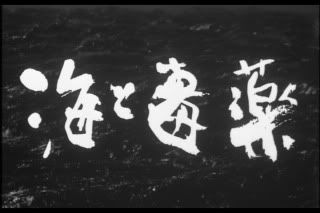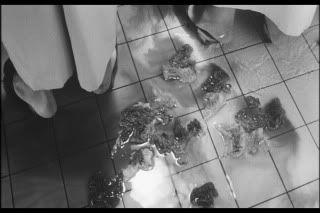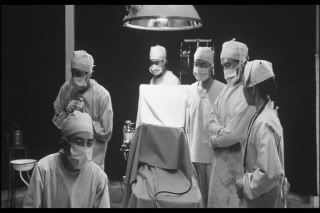"All There Is To Know About Adolph Eichmann" - Leonard Cohen

EYES:.............................................Medium
HAIR:.............................................Medium
WEIGHT:......................................Medium
HEIGHT:.......................................Medium
DISTINGUISHING FEATURES.......None
NUMBER OF FINGERS:....................Ten
NUMBER OF TOES.............................Ten
INTELLIGENCE...........................Medium
What did you expect?
Talons?
Oversize incisors?
Green Saliva?
Madness?

The above quoted poem is Leonard Cohen's reply to Hannah Arendt's writings on the banality of evil.
Kei Kumai's THE SEA AND POISON takes us down a similar path. Based on a novel by Shusaku Endo, tries to imagine the circumstances around the real-life war atrocities that occurred at Kyushu University. There, in 1945, Japanese doctors performed vivisections on downed American fliers. Shot in startlingly vivid black and white, THE SEA AND POISON shows how these events were not motivated by some supreme evil, but by mere pettiness, fear, and our most callow human emotions.

The story of the vivisections is framed by scenes taking place in a post-war holding cell. There, a series of prisoners, beginning with Sugoro (Eiji Okuda), relate their story to the Americans holding them.
Sugoro is probably the most sympathetic character, so its understandable that the entire first half of the film focuses on him. We learn that the university is in need of a new dean of medicine, and the two likeliest candidates are the heads of First and Second Surgery. An intern at the university, Sugoro works in First Surgery under Professor Hashimoto; there, he has become attached to an old lady dying of TB.
The competition for the dean's seat pushes Professor Hashimoto, and his associates, to perform some ill-advised surgeries, in the name of impressing the decision-makers. Though Sugoro's favoured patient may be able to recover slowly, or at least die at her own pace, the doctors decide to try a risky new surgery on her, one which has a 95% of killing her. She gets a reprieve, though, when they decide that an even more attractive option is to move up the surgery of a young woman with important connections. The lung surgery they hope to perform is supposed to be relatively risk-free, but, in an astonishing and tense surgery scene that really has to be seen, the patient dies.

With this major black mark against him, Professor Hashimoto has to find some other way to impress the right people, and thus get the dean's seat. He decides, in collaboration with the military authorities, to perform the aforementioned vivisections on downed American servicemen. The servicemen in question supposedly come from the very planes that have been randomly bombing the area, which has often put the university in danger. Since those captured have already been sentenced to death, the doctors of the university reason that the moral thing to do is to make sure that their deaths contribute to science. The first procedure, for instance, involves seeing how much of a man's lungs can be removed before he dies. Gruesome stuff.
The motivations of those involved are pretty clearly spelled out. Professor Hashimoto hopes that it will strengthen his case for the dean's seat; his right hand man sees it as a way to perhaps pass over Hashimoto. Toda (Ken Watanabe), one of the more interesting characters, is doing it to see if he is capable of empathy; as long as he's been training as a doctor, he's never felt an actual sympathetic bond with a patient. Ueda, a nurse, is doing it out of some sort of twisted jealousy, and Ohba, the head nurse, out of love. Sugoro, on the other hand, is doing it simply because he's afraid not to.
And of course, it's this question--why would a human being do this sort of thing?--that is at the heart of the movie. The collective reasons are all petty, small, and mundane; this is no master plot, but a product of weakness and careerism. Perhaps the weak link in the chain is the military officers who show up for the vivisections; they gloat over and enjoy the horrors they witness, and seem to have no motivation to do so, beyond sheer stupidity and evilness.

The real genius of the film isn't its characters or their emotions, though, no matter how well those are often carried out. Instead, THE SEA AND POISON offers its viewers some of the most astonishing black and white images ever set to film--think Andrei Takovsky's STALKER. (I'd be afraid that someone will quibble with me over this comparison, but let's face it, how likely is it that someone's seen both films AND reads this blog?).
Kumai is also a master of claustrophobic suspense. The two surgery scenes that are the major action of the film--the earlier lung surgery, and the later vivisection--are incredibly realistic, and the tension is palpable--and this is from someone who doesn't care for medical dramas at all.
The surgeries are gruesome, sure, but in a very realistic way. If you read a synopsis of the film, you may be worried that you're going to get some sort of CANNIBAL HOLOCAUST-type exploitation film: SEE! THE TERRORS OF HUMAN EXPERIMENTATION! Instead, you get something deeply human.
Kei Kumai's THE SEA AND POISON takes us down a similar path. Based on a novel by Shusaku Endo, tries to imagine the circumstances around the real-life war atrocities that occurred at Kyushu University. There, in 1945, Japanese doctors performed vivisections on downed American fliers. Shot in startlingly vivid black and white, THE SEA AND POISON shows how these events were not motivated by some supreme evil, but by mere pettiness, fear, and our most callow human emotions.

The story of the vivisections is framed by scenes taking place in a post-war holding cell. There, a series of prisoners, beginning with Sugoro (Eiji Okuda), relate their story to the Americans holding them.
Sugoro is probably the most sympathetic character, so its understandable that the entire first half of the film focuses on him. We learn that the university is in need of a new dean of medicine, and the two likeliest candidates are the heads of First and Second Surgery. An intern at the university, Sugoro works in First Surgery under Professor Hashimoto; there, he has become attached to an old lady dying of TB.
The competition for the dean's seat pushes Professor Hashimoto, and his associates, to perform some ill-advised surgeries, in the name of impressing the decision-makers. Though Sugoro's favoured patient may be able to recover slowly, or at least die at her own pace, the doctors decide to try a risky new surgery on her, one which has a 95% of killing her. She gets a reprieve, though, when they decide that an even more attractive option is to move up the surgery of a young woman with important connections. The lung surgery they hope to perform is supposed to be relatively risk-free, but, in an astonishing and tense surgery scene that really has to be seen, the patient dies.

With this major black mark against him, Professor Hashimoto has to find some other way to impress the right people, and thus get the dean's seat. He decides, in collaboration with the military authorities, to perform the aforementioned vivisections on downed American servicemen. The servicemen in question supposedly come from the very planes that have been randomly bombing the area, which has often put the university in danger. Since those captured have already been sentenced to death, the doctors of the university reason that the moral thing to do is to make sure that their deaths contribute to science. The first procedure, for instance, involves seeing how much of a man's lungs can be removed before he dies. Gruesome stuff.
The motivations of those involved are pretty clearly spelled out. Professor Hashimoto hopes that it will strengthen his case for the dean's seat; his right hand man sees it as a way to perhaps pass over Hashimoto. Toda (Ken Watanabe), one of the more interesting characters, is doing it to see if he is capable of empathy; as long as he's been training as a doctor, he's never felt an actual sympathetic bond with a patient. Ueda, a nurse, is doing it out of some sort of twisted jealousy, and Ohba, the head nurse, out of love. Sugoro, on the other hand, is doing it simply because he's afraid not to.
And of course, it's this question--why would a human being do this sort of thing?--that is at the heart of the movie. The collective reasons are all petty, small, and mundane; this is no master plot, but a product of weakness and careerism. Perhaps the weak link in the chain is the military officers who show up for the vivisections; they gloat over and enjoy the horrors they witness, and seem to have no motivation to do so, beyond sheer stupidity and evilness.

The real genius of the film isn't its characters or their emotions, though, no matter how well those are often carried out. Instead, THE SEA AND POISON offers its viewers some of the most astonishing black and white images ever set to film--think Andrei Takovsky's STALKER. (I'd be afraid that someone will quibble with me over this comparison, but let's face it, how likely is it that someone's seen both films AND reads this blog?).
Kumai is also a master of claustrophobic suspense. The two surgery scenes that are the major action of the film--the earlier lung surgery, and the later vivisection--are incredibly realistic, and the tension is palpable--and this is from someone who doesn't care for medical dramas at all.
The surgeries are gruesome, sure, but in a very realistic way. If you read a synopsis of the film, you may be worried that you're going to get some sort of CANNIBAL HOLOCAUST-type exploitation film: SEE! THE TERRORS OF HUMAN EXPERIMENTATION! Instead, you get something deeply human.










2 comments:
I've seen both films and I'm reading this blog. ;-)
Very ccreative post
Post a Comment